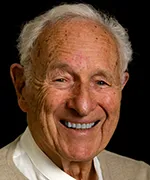
NIH | Dr. Irwin Arias, emeritus senior scientist at the National Institutes of Health, highlighted the importance of studying the polarity of liver cells on Sept. 19, the latest installment in Georgetown University's Distinguished Scientist Seminar Series.
Dr. Irwin Arias, emeritus senior scientist at the National Institutes of Health (NIH) and a renowned doctor in the field of hepatology, the study of the liver, emphasized the importance of studying the polarity of liver cells as part of the Distinguished Scientist Seminar Series Sept. 19.
Arias, age 98, an emeritus professor at Albert Einstein College of Medicine and Tufts University, has studied the liver for over 60 years. In his talk, he discussed liver cells’ polarity — each liver cell has two poles, apical or basolateral, with different properties.
Arias proposed that polarity was essential to the beginning of life, starting from simple eukaryotic cells, which contain nuclei that house genetic material.
“From the first origin of a eukaryotic cell, they had to be able to separate the inside from the outside in some directional way, and so polarity began with the origin of life,” Arias said at the event.
Despite biophysicists, evolutionary scientists, developmentalists and geneticists actively studying cell polarity, Arias said that the scientific community has yet to reach a comprehensive understanding of hepatocyte polarity. Prior to Arias’ work, hepatology textbooks lacked any mention of the term “polarity.”
“There is no other liver textbook, GI text, cellular or pathological text where the word ‘polarity’ is used in relation to the liver,” Arias said.
Previously, scientists believed that a sodium-pumping protein on the cell’s basolateral side was primarily responsible for excreting most bodily products. Arias’ research found that six sites on the cell’s apical pole were in fact playing a crucial role in ion excretion, or the transport of ions into the lumen.
Arias said hepatocytes are the only cells in the body where the apical sides of two cells join to form the bile canaliculus — a thin tube that collects and transports bile secreted by hepatocytes. However, if these hepatocytes lose their polarity, they also lose their function, becoming unable to facilitate the movement of substances such as ATP, the main source of cellular energy, throughout the body.
“That was our change in paradigm. This was the first demonstration that ATP was being used for the transporter of the apical domain to pump something out,” Arias said at the event.
Arias’ research focuses on whether mutations affecting hepatocyte apical polarity result in heritable diseases. To illustrate the significance of this work, Arias discussed a case study on Davidson’s disease, a disease in which hepatocytes lose their polarity, meaning that fluid cannot be reabsorbed from the blood into the tissue, resulting in chronic diarrhea.
Blythe Shepard, an associate professor of human science at Georgetown University, said the seminar gave nuance to the study of hepatology and that she hopes to utilize this knowledge in her research.
“One of things we are doing in the lab is looking at diabetic and metabolic diseases and how they impact the kidney and liver, and for the liver it is hard to look for basic polarity using histological stains,” Shepard told The Hoya.
Furthermore, Moshe Levi, professor in the departments of biochemistry and molecular and cellular biology at Georgetown University Medical Center, said Arias’ work can be applied to research on multiple diseases.
“Simple cell physiology of the liver explains many complex diseases, and we have to be aware of these problems when we study them,” Levi told The Hoya.
Arias has worked to increase awareness of hepatocyte polarity and facilitate future research, participating in international multidisciplinary programs and establishing programs to encourage further investigation into the acquired and inherited nature of various hepatological diseases.
“We put all the names in the hat and created a program that was completely random, so the biophysicists sat and listened to the geneticists and it was a spectacular event that has allowed biology to be applied to the concept of polarity in regards to the liver,” Arias said.